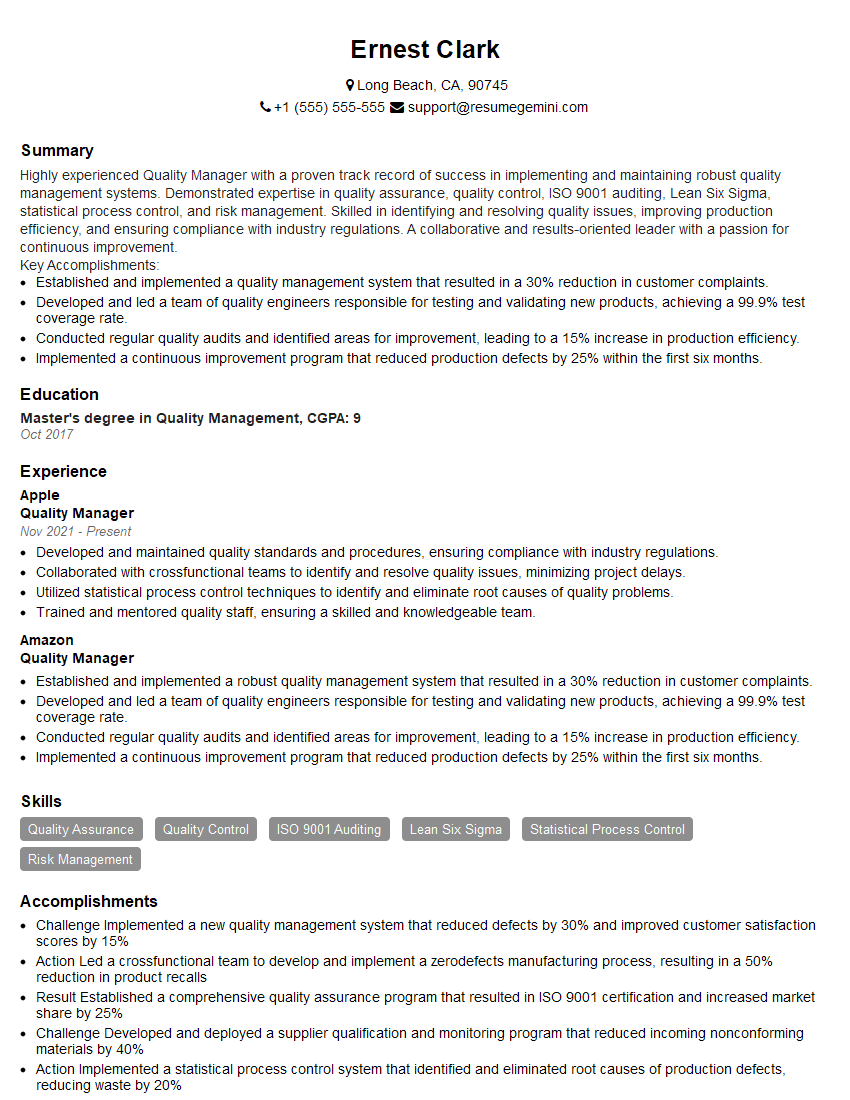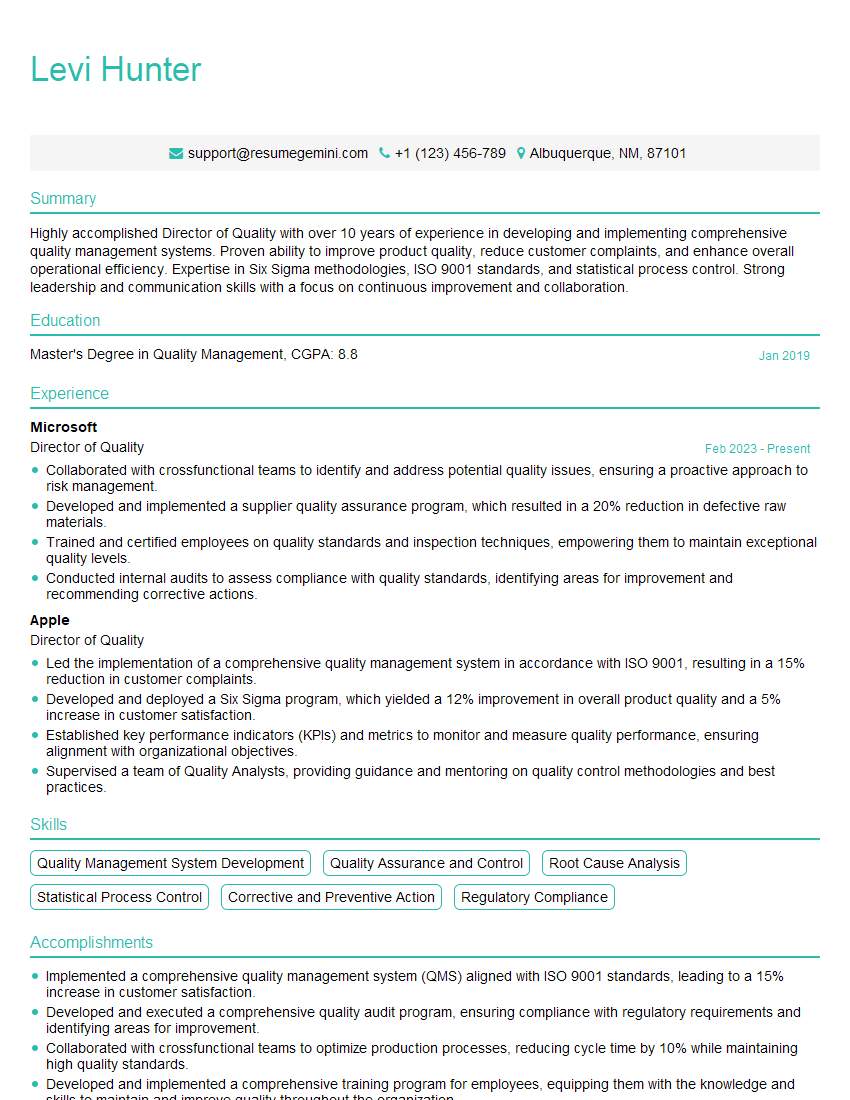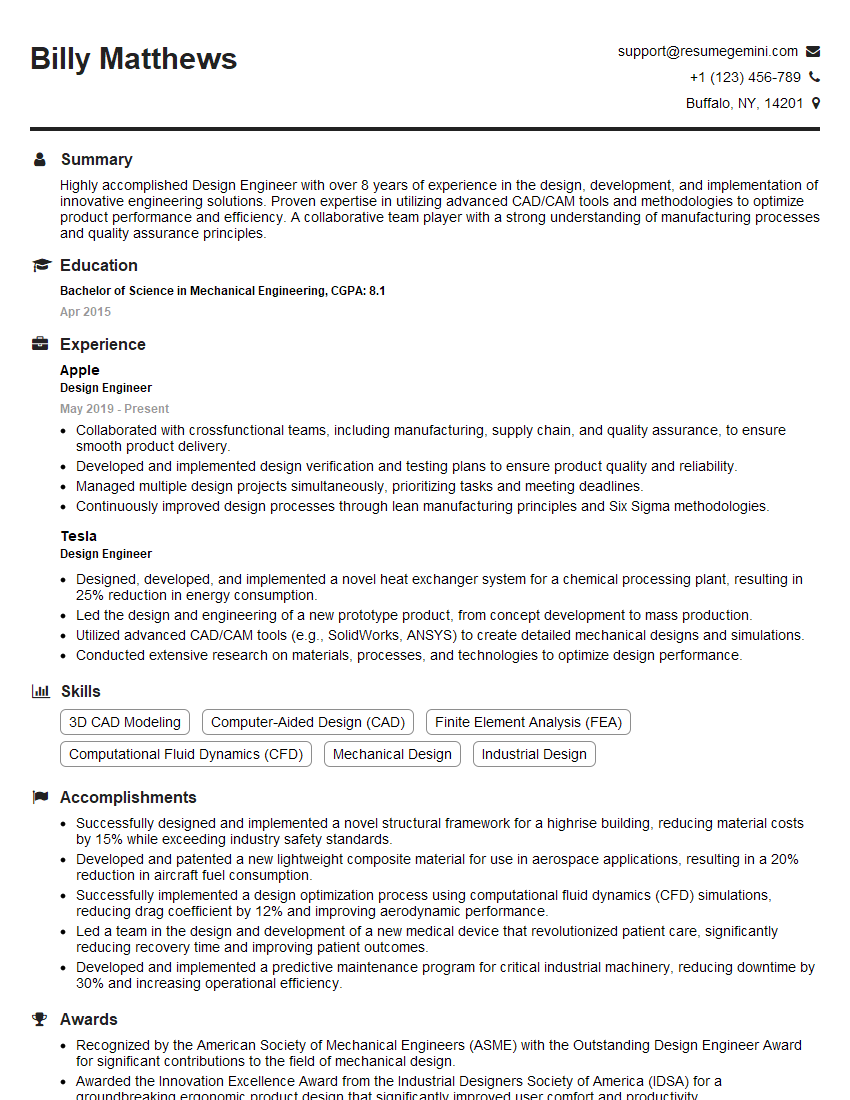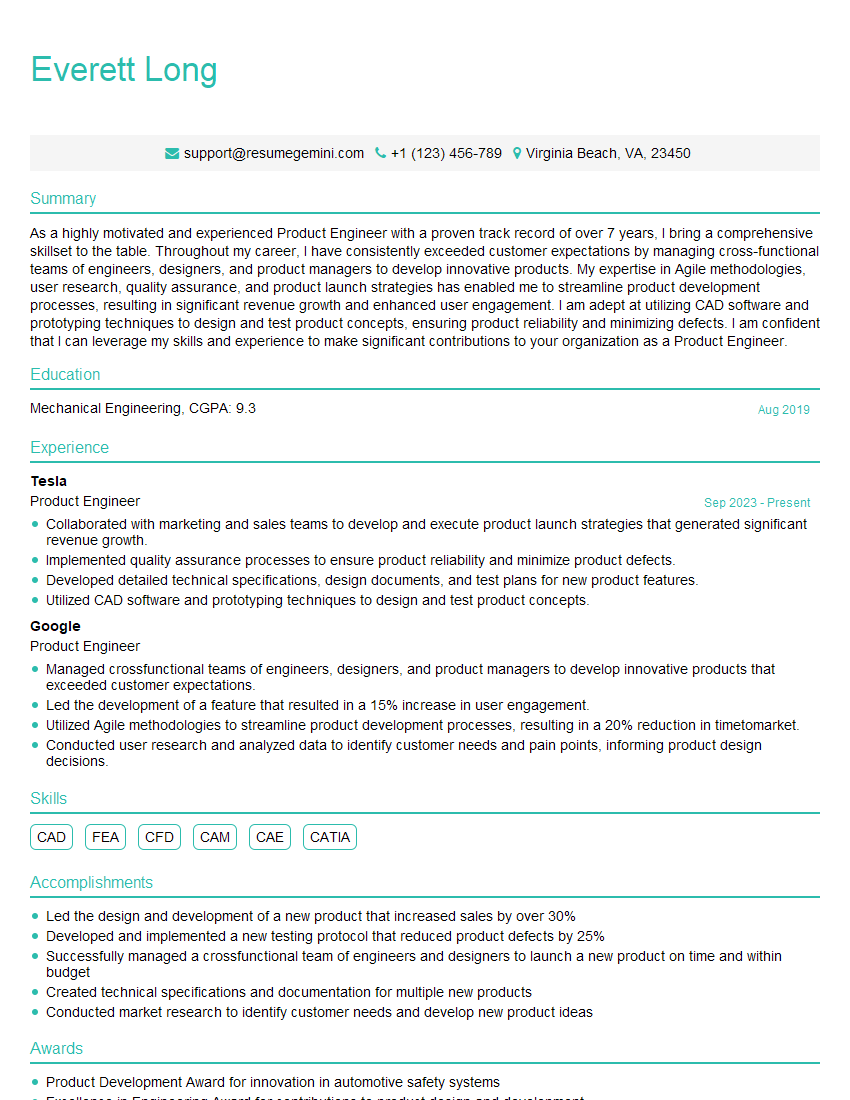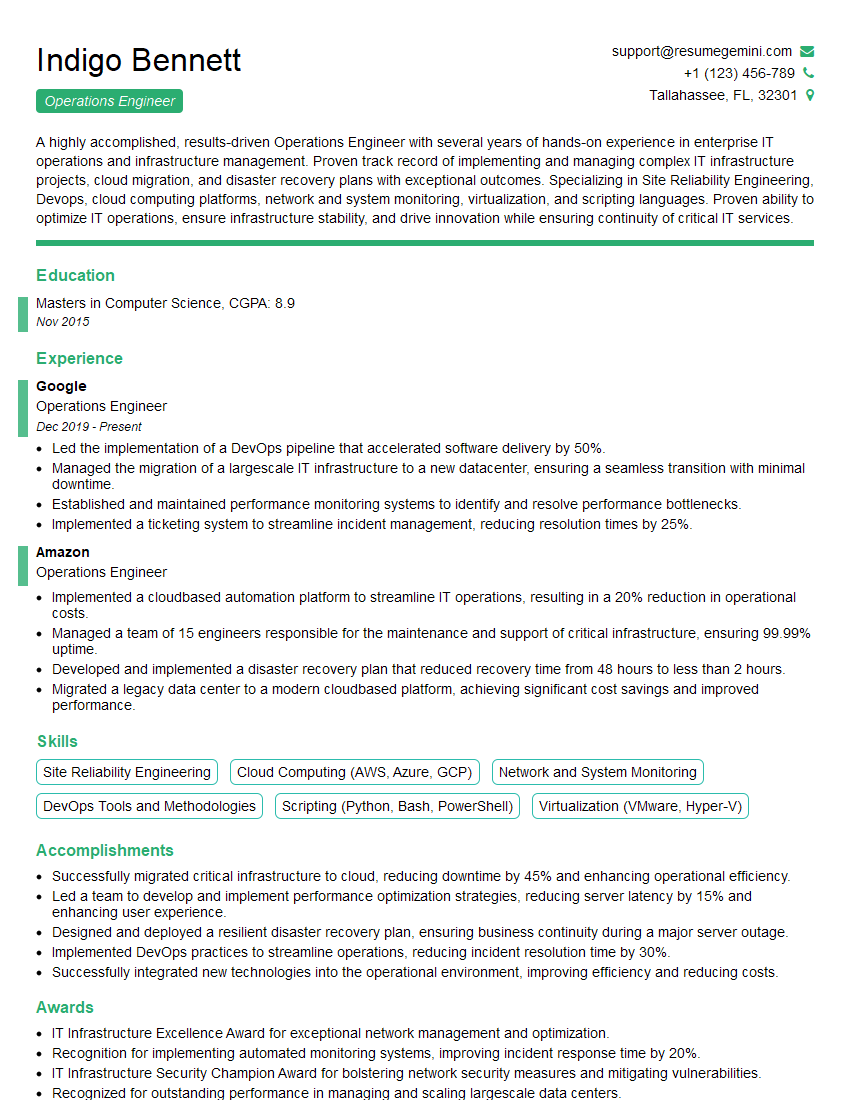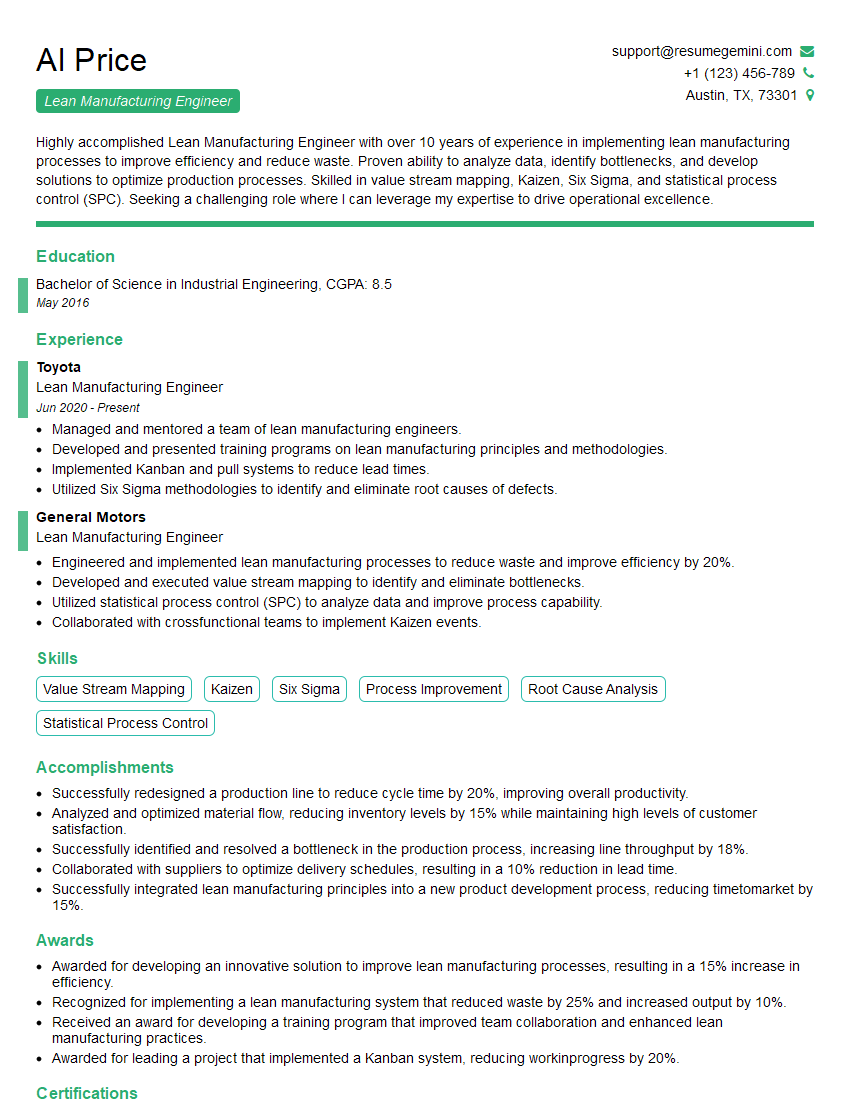Feeling uncertain about what to expect in your upcoming interview? We’ve got you covered! This blog highlights the most important Failure Modes and Effects Analysis (FMEA) for Manufacturing interview questions and provides actionable advice to help you stand out as the ideal candidate. Let’s pave the way for your success.
Questions Asked in Failure Modes and Effects Analysis (FMEA) for Manufacturing Interview
Q 1. Explain the purpose of a Failure Modes and Effects Analysis (FMEA).
A Failure Modes and Effects Analysis (FMEA) is a systematic, proactive method used to identify potential failure modes in a system or process and assess their potential effects. Its primary purpose is to prevent failures before they occur, minimizing risks and improving the reliability and safety of products, processes, or services. Think of it as a preemptive strike against potential problems, allowing you to address them before they cause significant damage or disruption.
By identifying potential problems early, FMEA helps organizations avoid costly recalls, warranty claims, and reputational damage. It fosters a culture of proactive risk management and continuous improvement.
Q 2. Describe the steps involved in conducting a typical FMEA.
Conducting an FMEA typically involves these steps:
- Define the System/Process: Clearly define the scope of the FMEA, specifying the system, subsystem, or process under analysis. For example, you might focus on the assembly process of a specific component in a car.
- Brainstorm Potential Failure Modes: Identify all potential ways the system or process could fail. This often involves a team brainstorming session with individuals from different departments to leverage diverse perspectives. Examples include: a part breaking, a machine malfunctioning, or a human error.
- Determine Potential Effects of Failures: For each failure mode, describe its potential effects on the system, the customer, and the organization. Will it impact safety, functionality, or cost? For example, a broken part might lead to a malfunctioning product, customer dissatisfaction, and warranty costs.
- Assess Severity (S): Rate the severity of each potential effect on a scale (typically 1-10, with 10 being the most severe). This reflects the impact on the customer and the organization.
- Assess Occurrence (O): Rate the likelihood of each failure mode occurring on a similar scale (1-10). This considers the frequency of the failure based on historical data or engineering judgment.
- Assess Detection (D): Rate the likelihood of detecting the failure mode before it reaches the customer on a scale (1-10). This considers the effectiveness of current controls and inspection methods.
- Calculate Risk Priority Number (RPN): Multiply the Severity, Occurrence, and Detection ratings (RPN = S x O x D). This provides a numerical value representing the risk priority.
- Prioritize Actions: Focus on the highest RPN values, addressing the most critical failure modes first.
- Develop and Implement Corrective Actions: Plan and implement actions to reduce the severity, occurrence, or detection of the failure modes. Document these actions.
- Verify Corrective Actions: Monitor the effectiveness of the implemented actions and revisit the FMEA periodically to update it based on new data and changes in the system or process.
Q 3. What is the difference between a Design FMEA (DFMEA) and a Process FMEA (PFMEA)?
While both DFMEA and PFMEA aim to identify and mitigate risks, they focus on different stages:
- Design FMEA (DFMEA): This is performed during the design phase of a product or process. It analyzes potential failure modes related to the product’s design itself. For example, it might examine the material selection, the geometry of a component, or the design’s robustness against anticipated stresses.
- Process FMEA (PFMEA): This is performed after the design is finalized and focuses on potential failure modes in the manufacturing or production process. This might look at aspects like assembly techniques, machine tolerances, or operator errors.
Think of it this way: DFMEA is about preventing problems from arising due to design flaws, while PFMEA is about preventing problems from arising during the manufacturing process.
Q 4. How do you determine the Severity, Occurrence, and Detection ratings in an FMEA?
Severity, Occurrence, and Detection ratings are subjective judgments made on a scale (typically 1-10), where 1 is the lowest and 10 is the highest.
- Severity (S): How severe would the effect of the failure be if it occurred? Consider its impact on safety, functionality, cost, and customer satisfaction. A catastrophic failure (e.g., product causing injury) would rate a 10, while a minor cosmetic defect might rate a 1.
- Occurrence (O): How likely is this failure mode to occur? Base this on historical data, process capability, and engineering judgment. A failure that has happened frequently would rate higher than one that is extremely rare.
- Detection (D): How likely is this failure mode to be detected before it reaches the customer? Consider the effectiveness of current controls, testing methods, and inspection procedures. A failure mode easily detected by existing processes would have a low rating.
These ratings are usually determined through a team consensus, often using pre-defined rating scales and guidelines to maintain consistency.
Q 5. Explain the concept of Risk Priority Number (RPN) and its significance.
The Risk Priority Number (RPN) is a simple multiplicative calculation of the Severity (S), Occurrence (O), and Detection (D) ratings: RPN = S x O x D. It provides a single numerical value to prioritize potential failure modes. A higher RPN indicates a higher risk requiring immediate attention.
The significance of RPN lies in its ability to rank and prioritize potential failure modes, allowing teams to focus their resources effectively on the most critical risks. It helps organizations to allocate resources and focus on those areas where the greatest gains in risk reduction can be achieved.
Q 6. How do you prioritize actions based on RPN values?
Actions should be prioritized based on the magnitude of the RPN values. Focus on failure modes with the highest RPN values first, as these represent the greatest risks. However, don’t solely rely on the RPN. Consider the potential consequences of a failure, even if the RPN is not the highest. A failure with a lower RPN but with significant safety implications should be addressed before a failure mode with a slightly higher RPN but minor consequences.
A prioritized list of corrective actions is crucial, detailing who is responsible, when the actions will be taken, and how their success will be verified. Regular review is vital to ensure that actions are implemented effectively.
Q 7. What are some common techniques for mitigating risks identified in an FMEA?
Several techniques can be used to mitigate risks identified in an FMEA. These techniques aim to reduce the Severity, Occurrence, or Detection ratings of potential failure modes:
- Design Modifications: Improve the design of the product or process to reduce the likelihood of failure (reduces Occurrence).
- Process Improvements: Optimize manufacturing processes to reduce errors and variability (reduces Occurrence and improves Detection).
- Material Selection: Choose higher quality or more robust materials to reduce the chance of material failure (reduces Occurrence and Severity).
- Improved Training: Train operators and technicians to better handle equipment and perform tasks, leading to fewer errors (reduces Occurrence).
- Enhanced Controls: Implement additional controls, such as automated inspections or redundant systems, to detect failures earlier (improves Detection).
- Redundancy: Design systems with backup components or processes to handle failures (reduces Severity).
- Warning Systems: Add sensors or alarms to provide early warning of potential failures (improves Detection).
The most effective mitigation strategies will depend on the specific failure mode and the context of the system or process being analyzed.
Q 8. Describe your experience with FMEA software tools.
My experience with FMEA software tools spans several platforms, from simple spreadsheets to sophisticated enterprise solutions. I’ve worked extensively with tools like Minitab, ReliaSoft, and specialized FMEA software integrated into PLM (Product Lifecycle Management) systems. Each tool offers unique advantages. Spreadsheets are great for simple FMEAs, offering flexibility but requiring meticulous manual tracking. More advanced software automates calculations, facilitates collaboration, and provides features like risk prioritization matrices and reporting dashboards. My proficiency lies not just in using these tools, but in understanding their limitations and selecting the most appropriate tool for the specific project scope and complexity. For instance, a complex automotive system would benefit from a robust PLM-integrated solution, while a smaller, less intricate project might be adequately managed with a spreadsheet. I’m comfortable adapting my approach based on the available resources and project requirements.
Q 9. How do you ensure the accuracy and completeness of an FMEA?
Ensuring accuracy and completeness in an FMEA is paramount. It’s a multi-step process that begins with clearly defining the system’s boundaries and functions. We meticulously list all potential failure modes, considering both hardware and software components, and human interactions. The team then assesses the severity, occurrence, and detection of each failure mode, using established rating scales (e.g., 1-10). A critical step is conducting thorough brainstorming sessions, utilizing techniques like fault tree analysis and HAZOP (Hazard and Operability Study) to uncover hidden failure modes. Regular peer reviews are also crucial to identify omissions or inconsistencies. Finally, the Risk Priority Number (RPN) calculation – the product of Severity, Occurrence, and Detection – helps prioritize the most critical failure modes. We use a combination of quantitative and qualitative data to make these assessments, accounting for uncertainties and expert judgment. A well-documented FMEA is essential. Each entry needs a clear justification and supporting evidence. This comprehensive approach ensures the FMEA is robust and reliable.
Q 10. How do you involve cross-functional teams in the FMEA process?
Cross-functional team involvement is essential for a successful FMEA. I typically involve representatives from design engineering, manufacturing, quality control, supply chain, and even marketing/sales, depending on the product and its lifecycle. Each team brings a unique perspective and expertise. For instance, manufacturing engineers can highlight potential assembly issues, while quality control can provide data on historical failures. I facilitate collaborative workshops, leveraging techniques like brainstorming and nominal group technique to encourage participation and avoid groupthink. Clear roles and responsibilities are established upfront. Regular communication channels are maintained to share updates and ensure everyone stays informed. Effective use of collaborative software can also help manage the process, allowing team members to contribute asynchronously. The goal is to create a shared understanding of risks and facilitate the development of robust mitigation strategies.
Q 11. How do you handle disagreements among team members regarding risk assessments?
Disagreements regarding risk assessments are inevitable. I handle them through a structured process of open discussion and data-driven decision-making. Instead of imposing a single viewpoint, I encourage each team member to clearly articulate their reasoning and supporting evidence. We may refer back to historical data, industry standards, or relevant test results to objectively evaluate different perspectives. If the disagreement persists, we might involve a subject matter expert or a neutral facilitator to help mediate and achieve consensus. Ultimately, the goal is not to eliminate disagreement but to foster informed decision-making. The FMEA document should clearly document any remaining uncertainties or areas of ongoing debate, along with a plan to address them through further investigation or testing.
Q 12. How do you update and maintain an FMEA over time?
An FMEA is a living document, not a static one. Regular updates and maintenance are crucial. The FMEA should be reviewed and updated whenever there are significant design changes, process improvements, or new data emerges. For example, post-production analysis might reveal previously unknown failure modes, requiring immediate updates. A clear schedule for periodic reviews (e.g., annually or after a certain production volume) should be established. The updates should focus on revising RPNs, adding new failure modes, updating mitigation strategies, and documenting the changes made. Version control is vital to track modifications and maintain a complete audit trail. Effective communication to all stakeholders about these updates ensures everyone remains aligned with the most current risk assessment.
Q 13. Describe a situation where your FMEA analysis prevented a significant failure.
During the development of a new automated assembly line, our FMEA identified a potential failure mode: the robotic arm could malfunction due to insufficient lubrication, resulting in a costly production downtime. While the initial risk assessment indicated a relatively low RPN, we used a fault tree analysis to dive deeper into the potential consequences of this failure. This revealed the possibility of a cascade effect, potentially damaging multiple components and causing significant production delays. Based on this, the team prioritized implementing an automated lubrication system, exceeding the initial mitigation strategy. This proactive measure prevented a costly shutdown during production ramp-up, saving the company significant time and money. The success underscored the importance of thorough investigation, even for seemingly low-risk failure modes.
Q 14. What are the limitations of FMEA?
Despite its many benefits, FMEA has limitations. It’s inherently subjective, relying on the experience and judgment of team members in assessing risk. The RPN calculation can be misleading, as it’s a simplified representation of complex interactions. Rare but catastrophic failures may have low RPNs, potentially overlooked if solely focused on the numerical value. FMEA also focuses on known failure modes and may miss unforeseen events or interactions. Furthermore, it can become time-consuming and resource-intensive for large complex systems. Despite these limitations, FMEA remains a valuable tool when used correctly and complemented with other risk assessment techniques. Its primary value lies in structured thinking and proactive risk mitigation, even if it cannot eliminate all uncertainty.
Q 15. How does FMEA relate to other quality management tools such as Control Plans or 5 Whys?
FMEA, Control Plans, and 5 Whys are all valuable quality management tools, but they serve different purposes and work best together. Think of them as parts of a larger system focused on preventing and mitigating problems.
FMEA is a proactive, predictive tool used to identify potential failure modes and their effects before they occur. It focuses on systematically evaluating the risks associated with each step in a process.
Control Plans are reactive, documenting the specific controls in place to prevent or detect the failures identified during FMEA. They outline the checks, inspections, and other measures to ensure the process stays within acceptable limits.
5 Whys is a problem-solving technique used to drill down to the root cause of a failure. While FMEA anticipates potential failures, 5 Whys helps determine the underlying cause of an actual failure to prevent recurrence. For example, if FMEA identifies a potential failure of a machine breaking down due to wear and tear, the 5 Whys would help uncover the true cause behind the excessive wear and tear (e.g., inadequate lubrication, improper operator training).
In essence, FMEA identifies potential problems, Control Plans define how to prevent or detect them, and 5 Whys helps understand why problems happened so improvements can be made to prevent future similar occurrences. They complement each other in a robust quality management strategy.
Career Expert Tips:
- Ace those interviews! Prepare effectively by reviewing the Top 50 Most Common Interview Questions on ResumeGemini.
- Navigate your job search with confidence! Explore a wide range of Career Tips on ResumeGemini. Learn about common challenges and recommendations to overcome them.
- Craft the perfect resume! Master the Art of Resume Writing with ResumeGemini’s guide. Showcase your unique qualifications and achievements effectively.
- Don’t miss out on holiday savings! Build your dream resume with ResumeGemini’s ATS optimized templates.
Q 16. Explain the concept of Failure Mode.
A Failure Mode is any way in which a product, process, or service could fail to meet its intended function. It describes how a specific part, component, or process could malfunction or deviate from its expected behavior. It’s not just about the failure itself, but *how* the failure happens.
For instance, consider an automated assembly line. A failure mode could be ‘motor burnout’ in a robotic arm. This isn’t simply ‘the robotic arm failing,’ it’s a specific *type* of failure. Another failure mode for the same arm could be ‘loss of grip,’ again detailing a specific way the function could be compromised. The clearer the description of the failure mode, the easier it is to analyze its effects and develop preventative measures.
Q 17. Explain the concept of Effects Analysis.
Effects Analysis is the crucial step after identifying failure modes where we determine the consequences of each failure mode. This involves assessing the impact of the failure on the product, process, or customer. The analysis considers severity, potential harm to the product, process or user, and the broader implications for the organization.
For example, if the failure mode is ‘motor burnout’ in the robotic arm, the effects analysis might include:
- Severity: Production stoppage, potential damage to other components, increased repair costs.
- Impact on product quality: Defective products, missed deadlines.
- Safety risks: Potential injury to operators.
A thorough effects analysis helps prioritize the failure modes based on their potential impact, allowing resources to be allocated effectively to address the most critical issues first.
Q 18. How do you identify potential failure modes in a manufacturing process?
Identifying potential failure modes in a manufacturing process requires a systematic approach involving several techniques:
- Process Mapping: Carefully mapping out the entire process, step-by-step, helps visualize potential points of failure.
- Brainstorming Sessions: Engaging cross-functional teams—engineers, operators, quality control personnel—to brainstorm potential issues from different perspectives is invaluable.
- Failure History Analysis: Reviewing past failure data, maintenance logs, and quality reports to identify recurring problems or patterns.
- Design Reviews: Critically examining designs and specifications to detect weak points or potential vulnerabilities.
- Industry Standards and Best Practices: Consulting industry standards, regulations, and best practices to identify common failure modes and mitigation strategies.
- DFMEA (Design FMEA): Performing a Design FMEA during the design phase identifies potential failure modes in the product design itself, before manufacturing begins.
A combination of these methods provides a comprehensive understanding of the potential failure modes within the manufacturing process.
Q 19. What are some common failure modes in your industry?
Common failure modes in manufacturing vary significantly by industry, but some examples across many sectors include:
- Equipment Malfunction: Machine breakdowns, sensor failures, control system errors.
- Material Defects: Raw material flaws, incorrect material specifications, improper handling.
- Process Errors: Incorrect process parameters, operator errors, inadequate training.
- Environmental Factors: Temperature fluctuations, humidity, contamination.
- Supplier Issues: Late deliveries, defective components from suppliers.
In my experience with automotive manufacturing, a particularly relevant failure mode is the inconsistent application of sealant, leading to leaks and component failure down the line.
Q 20. How do you validate the effectiveness of corrective actions taken based on FMEA recommendations?
Validating the effectiveness of corrective actions is essential to ensure FMEA’s success. We use several methods:
- Monitoring Key Performance Indicators (KPIs): Tracking relevant metrics (e.g., defect rates, downtime, customer complaints) to measure the impact of the implemented actions. This provides quantitative data to show improvement.
- Process Audits: Regularly auditing the process to verify that the corrective actions are being followed and that the controls are functioning as intended.
- Data Analysis: Analyzing post-implementation data to see if the frequency or severity of the identified failure modes have decreased. Statistical process control (SPC) charts can be particularly helpful.
- Feedback Collection: Gathering feedback from operators, maintenance personnel, and quality control teams to assess the practicality and effectiveness of the actions.
- Re-evaluation of the FMEA: Periodically re-evaluating the FMEA itself, updating it with new data, and incorporating lessons learned. This keeps the analysis relevant and effective over time. A common practice is to perform a review at least annually.
If the implemented actions fail to yield the desired results, a deeper investigation is needed to identify any underlying issues or gaps in the implemented strategies.
Q 21. How do you incorporate customer feedback into your FMEA process?
Customer feedback is a goldmine for identifying potential failure modes that might otherwise be missed. We incorporate it in several ways:
- Customer Complaint Analysis: Systematically analyzing customer complaints to identify recurring issues or patterns related to product or service failures. This is direct feedback on actual failures, informing the updating and improvement of the FMEA.
- Surveys and Feedback Forms: Using surveys and feedback forms to gather broader customer perspectives on product performance and identify areas of potential concern. This can reveal latent issues that customers may be experiencing before they escalate into major complaints.
- Warranty Claims Analysis: Analyzing warranty claims data to pinpoint common failure points and areas for improvement. Warranty claims represent actual failures impacting customers, providing valuable insights for updating the FMEA.
- Focus Groups and Interviews: Conducting focus groups and interviews with customers to gain deeper insights into their experiences and identify potential failure modes that may not be readily apparent.
By actively seeking and analyzing customer feedback, we enhance the accuracy and effectiveness of the FMEA, making it a more robust tool for preventing failures and improving customer satisfaction.
Q 22. How familiar are you with Automotive FMEA standards (AIAG)?
I’m very familiar with the Automotive Industry Action Group (AIAG) FMEA standards. These standards provide a structured approach to identifying, analyzing, and mitigating potential failures in manufacturing processes and designs. My experience includes utilizing the AIAG’s recommended format and terminology, ensuring consistent application across various projects. I understand the importance of following the guidelines for Severity, Occurrence, and Detection (S, O, D) ratings, Risk Priority Number (RPN) calculations, and the documentation required for a robust FMEA. I’ve used these standards extensively in projects involving automotive components, such as engine parts and safety systems, where adherence to AIAG guidelines is critical for ensuring product quality and safety.
Q 23. How familiar are you with different FMEA formats and templates?
My experience encompasses several FMEA formats and templates, including the classic AIAG format, as well as variations used within specific companies or for specialized applications. For instance, I’ve worked with design FMEA (DFMEA) focused on product design vulnerabilities and process FMEA (PFMEA) focusing on manufacturing process issues. I’m also comfortable using different software solutions designed to manage and analyze FMEA data. The core principles remain the same across these variations: identifying potential failure modes, analyzing their effects, and implementing corrective actions. The key differences often lie in the level of detail required, the specific terminology used, and the software tools employed for tracking and analysis.
- AIAG DFMEA/PFMEA: The industry standard format, widely used for its comprehensiveness and structured approach.
- Simplified FMEA: A streamlined version, often used for less complex projects or quick assessments.
- System FMEA: Used for complex systems to analyze interactions between multiple components and processes.
Q 24. Describe your experience using statistical methods in FMEA analysis.
Statistical methods are vital for objective FMEA analysis, moving beyond subjective assessments. I use statistical data, where available, to inform the Occurrence (O) rating. For example, if historical data shows a specific machine produces defects at a rate of 2%, this factual information is used instead of a purely subjective guess. Furthermore, I use control charts and process capability studies (e.g., Cpk) to assess process stability and identify potential areas for improvement. This quantitative approach significantly improves the accuracy of the RPN calculation and prioritization of corrective actions. In cases where historical data is limited, I work with engineering teams to develop data collection plans to gather the necessary information for a more accurate FMEA.
For instance, during an FMEA for a robotic welding process, I leveraged historical data on weld failures to determine the occurrence rate. Further, I utilized process capability analysis to assess the stability of the welding parameters, which informed the severity and detection ratings.
Q 25. Explain your approach to documenting and communicating FMEA findings.
Effective documentation and communication are crucial for FMEA success. I utilize a combination of techniques to ensure clear and concise reporting. The FMEA itself is meticulously documented using a standardized template (typically AIAG), ensuring consistency and clarity. This includes clearly defined failure modes, effects, causes, current controls, severity, occurrence, detection, RPN, recommended actions, and responsibility assignments with deadlines. Post-FMEA, I often create summary reports highlighting key findings, prioritized actions, and potential risks. These reports are tailored to the audience – management may need a high-level overview, while engineers require detailed information. Presentations and team meetings are used to communicate findings and ensure everyone understands the implications and agreed-upon actions.
For example, in a recent project, I presented FMEA findings to the management team using a visually appealing dashboard that prioritized the highest-risk items. Then, I conducted a separate workshop with the engineering team to detail corrective actions and their implementation strategies.
Q 26. What is the role of risk management in FMEA?
Risk management is the cornerstone of FMEA. The entire process is dedicated to identifying potential risks (failure modes), analyzing their potential impact (severity), likelihood of occurrence, and detectability. The RPN calculation is a direct measure of risk. A high RPN indicates a high-risk item requiring immediate attention. Risk management in FMEA is not just about identifying problems; it’s about prioritizing actions to mitigate these risks based on their relative importance. This involves determining the most effective and cost-efficient countermeasures to reduce the severity, occurrence, or detection of potential failures. The iterative nature of FMEA allows for ongoing risk assessment and adjustments as the design, process, or product evolves.
Q 27. How do you manage changes to a design or process that impact an existing FMEA?
Whenever a design or process change impacts an existing FMEA, a thorough review and update are essential. My approach involves a structured process:
- Identify impacted areas: Pinpoint which aspects of the FMEA are directly affected by the change.
- Re-evaluate the FMEA: Carefully re-assess the severity, occurrence, and detection ratings for affected failure modes. This often requires reviewing historical data or performing new analyses.
- Update the RPN: Recalculate the RPN to reflect the changes. This helps prioritize the necessary corrective actions.
- Document changes: Clearly document all changes made to the FMEA, including the rationale behind the modifications. Version control is crucial.
- Communicate updates: Inform relevant stakeholders of the changes and their implications.
Failing to update the FMEA after a design or process change can lead to inaccurate risk assessments and potentially costly consequences. Therefore, maintaining an up-to-date FMEA is crucial for effective risk management.
Q 28. What are some potential challenges you anticipate in conducting a new FMEA?
Several challenges can arise during a new FMEA. These include:
- Data availability: Lack of historical data can make accurate occurrence rating difficult. This requires proactive data collection plans.
- Team involvement: Securing the active participation of all relevant stakeholders (engineering, manufacturing, quality) is crucial for a comprehensive FMEA. Lack of engagement can lead to incomplete or inaccurate assessments.
- Defining scope: Clearly defining the scope of the FMEA to avoid unnecessary complexity or omission of critical failure modes is essential.
- Subjectivity in ratings: Minimizing subjectivity in Severity, Occurrence, and Detection ratings requires a structured and objective approach with well-defined criteria. Calibration among the team members is essential to ensure consistent rating.
- Resource constraints: Time and budget limitations can impact the depth and thoroughness of the FMEA.
Addressing these challenges requires careful planning, strong team leadership, and effective communication to ensure a robust and useful FMEA.
Key Topics to Learn for Failure Modes and Effects Analysis (FMEA) for Manufacturing Interview
- Understanding FMEA Fundamentals: Define FMEA, its purpose, and its benefits in a manufacturing context. Grasp the key differences between DFMEA (Design FMEA) and PFMEA (Process FMEA).
- The FMEA Process: Thoroughly understand each step of the FMEA process: planning, structuring the team, identifying potential failure modes, assessing severity, occurrence, and detection, calculating the Risk Priority Number (RPN), and developing recommended actions.
- Failure Mode Identification Techniques: Become proficient in various techniques for identifying potential failure modes, such as brainstorming, fault tree analysis, and experience-based methods.
- Severity, Occurrence, and Detection (S-O-D) Ratings: Master the criteria for assigning numerical ratings to severity, occurrence, and detection, and understand how these contribute to the RPN.
- Risk Priority Number (RPN) Analysis and Prioritization: Learn to interpret RPN values, prioritize potential failures based on risk, and justify your prioritization decisions.
- Recommended Actions and Implementation: Understand how to develop effective corrective actions to mitigate risks, and the importance of verifying their effectiveness.
- FMEA Documentation and Reporting: Familiarize yourself with best practices for documenting and presenting FMEA results in a clear and concise manner.
- Practical Application in Manufacturing Processes: Be prepared to discuss how FMEA is applied to various manufacturing processes, such as assembly, machining, and quality control.
- Software Tools for FMEA: Demonstrate familiarity with common software tools used for conducting and managing FMEA (mentioning specific tools is optional, focus on general understanding).
- Continuous Improvement and FMEA Updates: Explain the iterative nature of FMEA and the importance of regularly reviewing and updating the analysis as processes change.
Next Steps
Mastering FMEA is crucial for advancing your career in manufacturing, demonstrating your commitment to quality, risk mitigation, and problem-solving. A strong understanding of FMEA significantly enhances your value to any manufacturing organization. To maximize your job prospects, create a compelling and ATS-friendly resume that highlights your FMEA skills and experience. ResumeGemini is a trusted resource that can help you build a professional resume tailored to the manufacturing industry. Examples of resumes tailored to Failure Modes and Effects Analysis (FMEA) for Manufacturing are available to guide you.
Explore more articles
Users Rating of Our Blogs
Share Your Experience
We value your feedback! Please rate our content and share your thoughts (optional).
What Readers Say About Our Blog
Interesting Article, I liked the depth of knowledge you’ve shared.
Helpful, thanks for sharing.
Hi, I represent a social media marketing agency and liked your blog
Hi, I represent an SEO company that specialises in getting you AI citations and higher rankings on Google. I’d like to offer you a 100% free SEO audit for your website. Would you be interested?
